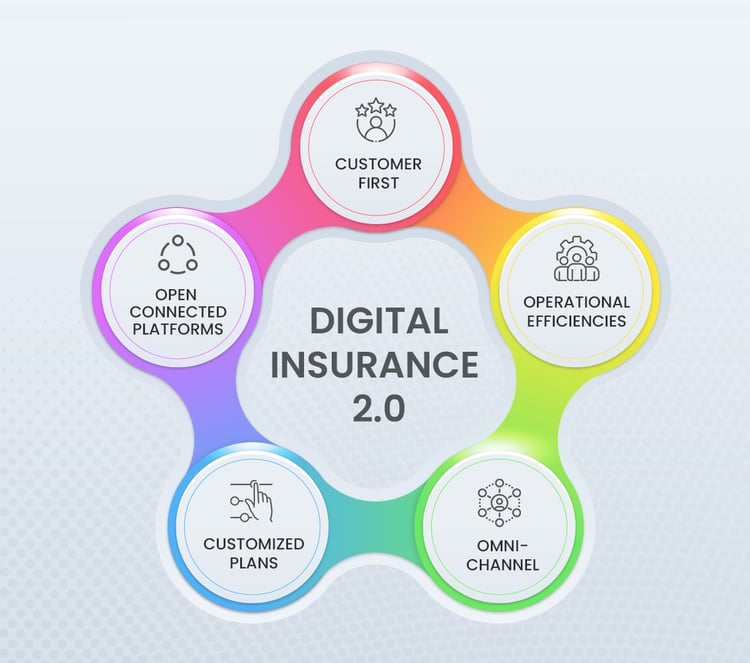Community Insurance Companies vs. Industry Giants - Strategies to Win

As 2024 gets underway, the insurance industry continues to grapple with the challenges it had in 2023. While geopolitical tensions, climate change, and economic uncertainties cast a shadow across the sector, smaller carriers, particularly regional insurance companies, have also to deal with increasing competition from insurance behemoths. They are facing intensified pressures on renewals, pricing, cycle times, and customer retention.
The larger insurance corporations have the sheer scale and resources to swiftly adapt to market changes, streamline operations, and meet evolving customer expectations through advanced digital solutions. This has set the stage for a modern David vs. Goliath struggle and emphasizes why regional and community insurance companies must stop thinking of digital transformation as a cost factor and start looking at it as an investment for success. Insurance companies that cannot keep up will be mercilessly left behind.
The changing face of insurance
The insurance industry was once neatly confined by clear boundaries dictating product types, distribution channels, and risk assessment. Today, a new reality is emerging.
-
Insurance has traditionally aligned with the needs and preferences of older generations. There is a critical gap in addressing the expectations of Gen . When 6 million new customers will be from this generation by 2025, the industry has to pivot now to meet the expectations of a generation that has grown up in a digital world.
-
Insurance companies may prioritize safeguarding their current market by leaning on adaptation initiatives rather than embracing innovation. This might yield short-term benefits but in the long run, this could result in a customer base skewed toward higher-risk profiles as the low-risk premiums might go to the insurance giants with a more bionic operating model.
-
Community insurance companies with monolithic core insurance platforms cannot leverage the new digital tools that customers crave or generate enterprise-level value.
4 Ways technology can grow business for smaller insurance companies
In the digital age, technology is no longer a cost; it's an asset. Managed effectively, it becomes a key driver of growth and profitability. For smaller insurance companies aiming to seize new opportunities, these are the four strategies that can drive an increased market share.
Digitalize core operations
Legacy technology is often the elephant in the room because while they might maintain the operational status quo they are not a force multiplier that increases business value. A recent PWC survey found that 41% of policyholders are ready to switch insurance providers if they don’t offer them the digital experience they expect. Companies that fail to meet their needs will find themselves falling behind.
A PWC survey found that 41% of policyholders are ready to switch insurance providers if they don’t offer them the digital experience they expect.
To succeed in such a world, insurers need a core insurance platform that supports operational and digital insurance capabilities. Insurance will continue to be a data-driven business but it will rely not just on historical data but also on real-time data for more accurate risk assessment, personalized products, and a faster claims process. If your current insurance software architecture is not built for this, it is time to evaluate a more scalable and agile core platform.
Hyper-personalization will drive customer growth
Everyone is talking about personalization, small and medium-sized insurers cannot just join this bandwagon - they need to stand out. David can win against the Goliaths if they make hyper-personalization their differentiating factor.
Hyper-personalization uses cutting-edge technologies like artificial intelligence (AI), advanced data analytics, hyperautomation, and predictive modeling to enable insurers to know precisely what their customers need. This is a technologically advanced version of the local expertise regional insurance companies always prided themselves on.
This approach ensures your business creates unique policies tailored to each customer's specific needs, preferences, lifestyles, and life events and stays away from the cookie-cutter approach that many large insurers still follow. This is a customer-centric growth strategy rather than the hitherto product-centric approach that is slowly being phased out.

Embedded insurance: Community insurance companies will ignore it at their peril
Smaller insurance companies must explore embedded insurance distribution; the insurance giants are already well on their way. This approach, where insurance is bought within another transaction, isn't new, but improved technology and customer data analytics make it increasingly appealing. It has the power to revolutionize traditional distribution channels, bypassing agents yet offering a smoother customer experience.
The central idea of embedded insurance distribution is to seamlessly integrate insurance into everyday products, promoting increased accessibility. Millennials and Gen Z are very comfortable with buying insurance at the point of need, for instance, bundled insurance along with an appliance purchase or travel insurance along with online flight bookings. This positive experience is why the embedded insurance market is set to soar from $63.1 billion in 2022 to $480 billion in 2033 (DataHorizzon Research). This is an opportunity that smaller insurance companies must take advantage of to emerge as victors.
Harness automation and AI to maximize productivity
Your producers are spending more time on non-revenue tasks. Similarly, your client services representatives are caught up with note-taking, responding to frequently asked questions, or updating records. This scenario extends to all employee functions and contributes to financial losses.
In the insurance sector, automation is increasingly streamlining various administrative and marketing processes. As we move into 2024, expect this trend in insurance technology to broaden its capabilities. AI-powered virtual assistants as well as increased automation in underwriting and claims management are already making their presence felt and many national insurance companies have invested in automation. AI is poised to have an impact on every facet of the insurance value chain, the question is how fast will it happen for the regional insurance companies.
Ignoring AI is risky for insurance CEOs. BCG data indicates that the proportion of insurance companies reporting a substantial financial impact (with at least 1% growth in EBIT margins) from AI investments has doubled, rising from 10% to 20%. This impact has stayed at 10% for other industries. The smaller insurers can choose wisely where to automate to gain the most advantage.
While there's an evident need for digital technology and transformation in the insurance sector, along with customer demand for it, community insurance companies grapple with justifying the costs associated with updating or replacing legacy systems. There is no two ways about it, if smaller insurance firms want to win big against the insurance giants, they need tech on their side.
The encouraging news is that the modernization of legacy applications doesn't have to be excessively expensive and there are big fish alternatives to the bigger insurtechs with their multi-level cost structure. SimpleSolve helps you compete to win viz a viz the industry giants, all within a pricing structure that makes business sense to our clients. Talk to us today!
Topics: Digital Transformation






